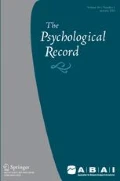Abstract
This article discusses the potential role of contingency adduction in creative behavior. Some have characterized creativity as the study of generativity. Generativity is the investigation of procedures that result in the occurrence of untrained, often composite, patterns from earlier trained components. An increasing number of applied programs are attempting to apply generative procedures in their design. Headsprout Early Reading®, for example, explicitly employed generative procedures to teach reading. There remains a lack of understanding about the role contingency adduction plays in the generative process. Contingency adduction is defined when patterns shaped under one context are recruited by contingencies in another context for which the pattern was not originally shaped. Adduced patterns may be new sequences of repertoires, the combination of repertoires, or the repertoire may acquire a new function. The moment of reinforcement of these new patterns from previously established patterns marks the moment of adduction. Thus, procedures that make such selection more likely may be fundamental to encourage what might be called creative behavior. Examples and nonexamples of contingency adduction involving both verbal and nonverbal procedures in both animals and humans will be described, and their implications noted.
Similar content being viewed by others
Data Availability
Not applicable.
References
Adams, G. L., & Engelmann, S. (1996). Research on direct instruction: 25 years beyond DISTAR. Educational Achievement Systems. Seattle, WA.
Andronis, P. T. (1983). “Symbolic aggression” by pigeons: Contingency adduction (Unpublished doctoral dissertation). University of Chicago, Chicago, IL.
Andronis, P. T., Layng, T. J., & Goldiamond, I. (1997). Contingency adduction of “symbolic aggression” by pigeons. Analysis of Verbal Behavior, 14(1), 5–17.
Binder, C. (1993). Behavioral fluency: A new paradigm. Educational Technology, 33(10), 8–14.
Binder, C. V. (1987). Fluency-building: Research background. Nonantum, MA: Precision Teaching & Management Systems.
Binder, C. V. (1988). Precision teaching: Measuring and attaining academic excellence. Youth and Policy, 10, 12–15.
Epstein, R. (1985). The spontaneous interconnection of three repertoires. The Psychological Record, 35(2), 131–141.
Epstein, R. (1999). Generativity theory. Encyclopedia of Creativity, 1, 759–766.
Gagne, R. M., & Foster, H. (1949). Transfer of training from practice on components in a motor skill. Journal of Experimental Psychology, 39(1), 47.
Gilbert, T. F. (1962). Mathetics: The technology of education. Journal of Mathetics, 1(1), 7–74.
Haughton, E. C. (1972). Aims—Growing and sharing. Faculty of Education: York University. Arlington, VA.
Haughton, E. C. (1980). Practicing practices: Learning by activity. Journal of Precision Teaching, 1(3), 3–20.
Holth, P. (2012a). Variability as an operant? The Behavior Analyst, 35(2), 243.
Holth, P. (2012b). The creative porpoise revisited. European Journal of Behavior Analysis, 13(1), 87–89.
Johnson, K., & Street, E. M. (2004). The Morningside Model of Generative Instruction: An integration of research-based practices. In Evidence-based educational methods (pp. 247–265). Academic Press. San Diego, CA.
Johnson, K., & Street, E. M. (2020). Generative responding through contingency adduction. In R. A. Rehfeldt, J. Tarbox, M. Fryling, & L. Hayes (Eds.), Applied behavior analysis of language and cognition. Oakland, CA: New Harbinger.
Johnson, K. R., & Layng, T. J. (1992). Breaking the structuralist barrier: Literacy and numeracy with fluency. American Psychologist, 47(11), 1475.
Johnson, K. R., & Layng, T. J. (1996). On terms and procedures: Fluency. The Behavior Analyst, 19(2), 281–288.
Kieta, A. (2017). Reinforcing variability produces stereotypic behavior. (Unpublished master’s thesis), University of North Texas, Denton, TX.
Layng, T. J. (2019). Tutorial: Understanding concepts: Implications for behavior analysts and educators. Perspectives on Behavior Science, 42(2), 345–363.
Layng, T. J., Twyman, J. S., & Stikeleather, G. (2004). Engineering discovery learning: The contingency adduction of some precursors of textual responding in a beginning reading program. Analysis of Verbal Behavior, 20(1), 99–109.
Neuringer, A. (2002). Operant variability: Evidence, functions, and theory. Psychonomic Bulletin & Review, 9(4), 672–705.
Neves Filho, H. B., Assaz, D. A., Dicezare, R. H. F., Knaus, Y. C., & Garcia-Mijares, M. (2020). Learning behavioral repertoires with different consequences hinders the interconnection of these repertoires in pigeons in the box displacement test. The Psychological Record, 70(2), 1–9.
Page, S., & Neuringer, A. (1985). Variability is an operant. Journal of Experimental Psychology: Animal Behavior Processes, 11(3), 429.
Pryor, K. W., Haag, R., & O’Reilly, J. (1969). The creative porpoise: Training for novel behavior 1. Journal of the Experimental Analysis of Behavior, 12(4), 653–661.
Ray, B. A. (1969). Selective attentions: The effects of combining stimuli which control incompatible behavior. Journal of the Experimental Analysis of Behavior, 12(4), 539–550.
Schiller, P. H. (1952). Innate constituents of complex responses in primates. Psychological Review, 59, 177–191.
Schiller, P. H. (1957). Innate motor action as a basis of learning. In C. Schiller (Ed.), Instinctive behavior: The development of a modern concept. International Universities Press. New York, NY
Tiemann, P. W., & Markle, S. M. (1985). Analysing instructional content: A guide to instruction and evaluation. Stipes Publishing. Champaign, IL
Weiss, M. J. (2001). Expanding ABA intervention in intensive programs for children with autism: The inclusion of natural environment training and fluency based instruction. Behavior Analyst Today, 2(3), 182.
Williams, P., Granzin, A., Engelmann, S., & Becker, W. C. (1979). Teaching Language to the truly naive learner: An analog study using a tactual vocoder. Journal of Special Education Technology, 2(3), 5–15.
Acknowledgements
Special thanks to Dr. T. V. “Joe” Layng, Dr. Paul Andronis, Dr. Joanne Robbins, and Awab Abdel Jalil for invaluable contributions to the development and revision of this manuscript.
Author information
Authors and Affiliations
Corresponding author
Ethics declarations
Conflicts of Interest
The authors have no conflicts of interest.
Code Availability
Not applicable.
Human and Animal Rights and Informed Consent
The present article did not use human or animal subjects and did not involve the acquisition of informed consent.
Additional information
Publisher’s Note
Springer Nature remains neutral with regard to jurisdictional claims in published maps and institutional affiliations.
Rights and permissions
About this article
Cite this article
Williams, N. The Role of Contingency Adduction in the Creative Act. Psychol Rec 71, 543–551 (2021). https://doi.org/10.1007/s40732-020-00440-z
Accepted:
Published:
Issue Date:
DOI: https://doi.org/10.1007/s40732-020-00440-z



